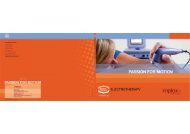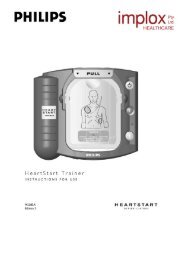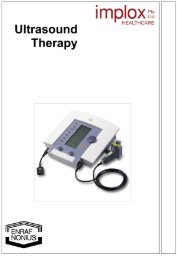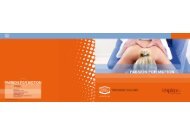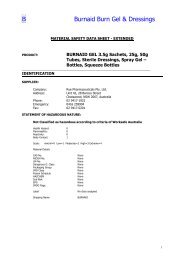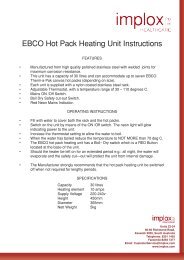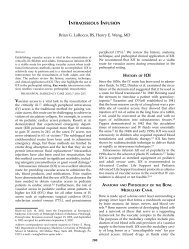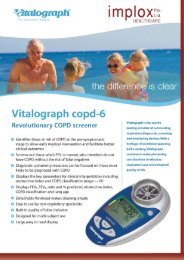Low and medium Frequency Electrotherapy - Implox
Low and medium Frequency Electrotherapy - Implox
Low and medium Frequency Electrotherapy - Implox
Create successful ePaper yourself
Turn your PDF publications into a flip-book with our unique Google optimized e-Paper software.
2.3.1 Howson<br />
Howson (7) states that it is best to use very short phase times for stimulation of the type II <strong>and</strong> type III nerve fibres, as<br />
well as for stimulation of the type I (Aα) motor neurons (Fig. 3).<br />
Fig. 3.<br />
The strength/duration curves of the different types of nerve fibre (Howson, 1978, from Li <strong>and</strong> Bak).<br />
The strength/duration curves of the different types of nerve fibre show that with phase times shorter than 200 μs it is<br />
possible to stimulate the sensory <strong>and</strong>/or motor nerves without stimulating the non-myelinated fibres (pain).<br />
In other words, with such short phase times it is possible to select a relatively high amplitude without stimulating the<br />
thin nerve fibres. There is thus a wide amplitude range. On the other h<strong>and</strong>, with longer phase times the different<br />
strength/duration curves lie so close together that a small increase in amplitude can result in stimulation of the thin<br />
nerve fibres. In this case, there is a narrow amplitude range.<br />
2.3.2 Lullies<br />
From investigations by Lullies (18,19) it is possible to draw certain conclusions regarding the conditions that an<br />
alternating current must meet for selective stimulation of the thick nerve fibres. These conditions are:<br />
• a ‘relatively’ low current;<br />
• a ‘relatively’ high frequency (above 3 Hz).<br />
Although the frequency of the <strong>medium</strong>-frequency alternating currents in interferential therapy differs from the optimum<br />
frequency, these currents are still able to stimulate the thick nerve fibres.<br />
Fig. 4.<br />
The amplitude of a sinusoidal alternating current plotted against frequency for type I (Aa) nerve fibres (myelinated<br />
motor neurons) <strong>and</strong> type IV (C) (non-myelinated autonomic) fibres of the sciatic nerve of a frog.<br />
9



